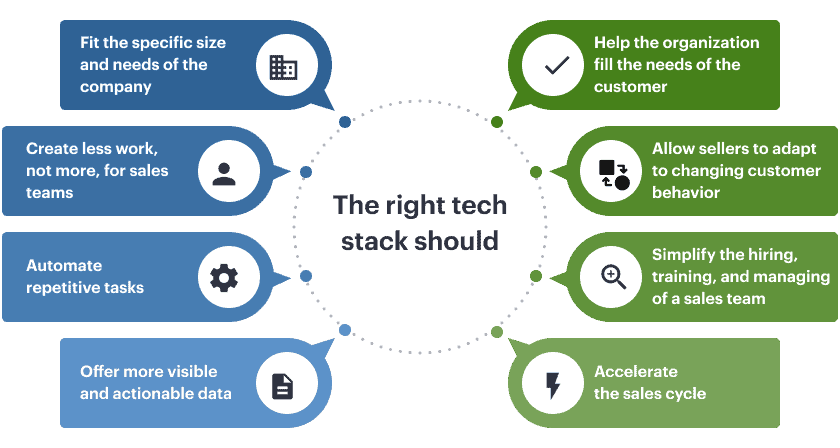Since the dawn of humanity, we have used tools to simplify the accomplishment of tasks. When we look at ancient stone bowls or bronze-age hammers found by archeologists, our brains can quickly identify what they were used for – and why they were necessary for daily life.
By 2022 advanced tools have branched off into so many categories that it can be hard to determine which ones we need, why, or how to even implement them. This is particularly true in the sales industry, where new sales technologies seem to pop up almost every day.
What are sales tools?
Sales tools are software used to boost a sales team’s productivity and revenue, free up time for sales professionals, and carry out certain other tasks that they can’t do themselves. In short, sales tools are applications that make sales jobs easier. In fact, LinkedIn reports that top salespeople cite sales technology as key to their success; a whopping 82% of them say sales tools are “critical” in their ability to close deals.
Types of sales tools
When it comes to sales tools, which are also commonly referred to as sales management tools, there are endless software options to choose from depending on an organization’s size, needs, and products. It can be tricky, though, to decide on the right tool or stack of tools for a business or team. The first step to solving this conundrum is becoming familiar with what tools are available and how they work.
It’s important to keep in mind that some sales tools overlap with each other in function; what’s more, many applications are hybrid sales tools created to cover multiple categories.
Sales CRM
What is Sales CRM? Sales CRM, or Customer Relationship Management, is the process by which a business administers interactions with customers and potential customers.
In that case, what is a CRM sales tool? A good CRM tool is typically one of the first tools that an organization invests in for its sales team. This software helps organizations keep track of existing customers and leads, improve customer relations, store relevant data, and it can even automate communication.
Sales Intelligence
Sales intelligence tools assist with the collection, integration, analysis, and presentation of prospect information so that salespeople know who they should be talking with – and how. Some of this information might be purchase history, current contracts, or other data present in the prospect’s digital footprint.
Intelligence data keeps reps from wasting precious time on a prospect that would not be ready to buy anyway, meanwhile letting them focus on those that are ready.
Sales Enablement
Because the definition of Sales Enablement can vary depending on who you ask, it’s difficult to pinpoint exactly all that a sales enablement tool should include. So, what are sales enablement tools? Generally speaking, a sales enablement platform provides visibility of the sales cycle and enables sellers to close more deals. This solution also helps connect sales, marketing, and customers.
Sales Acceleration
As the name implies, sales acceleration tools aim to speed up the sales cycle and close more deals faster. This sounds similar to sales enablement, but the latter is more about equipping salespeople with quality opportunities and materials, while sales acceleration focuses on increasing efficiency by better organizing the sales process. To this end, sales acceleration tools usually have multiple features bundled together.
Sales Analytics
Sales analytics tools work to identify, model, and predict sales trends while aiding sales teams in understanding how to improve. Sales analytics rely on data that is compiled both manually and automatically. Although the use of data and sales analytics is on the rise, according to Salesforce only 53% of fast-growing companies claim to be effective at harnessing these tools; for slow-growing companies, this number drops to just over a third.
Sales Productivity Tools
This category tackles hurdles to seller productivity. Administrative tasks and data entry are some of the biggest hurdles, so accordingly sales productivity tools incorporate automation and time-saving functions. Many of the other tool categories are also, effectively, sales productivity tools.
Customer Success Tools
What is customer success software? Customer success applications target customer satisfaction, ensuring their experience is what they expected from the product or service. This customer-centric tool harnesses data and provides businesses with a detailed analysis of the customer’s profile, behavior, and feedback. Teams can identify and address customer dissatisfaction while improving retention rates through a better relationship.
Social Selling Tools
Social selling is a buzzword right now – and it’s no wonder as to why. With everyone and their grandma online nowadays, you can reach anyone and find just about any information you could need. Social selling tools let sales reps connect with prospects by leveraging social media networks. Yet this category consists of more than your well-known social platforms: it also includes tools for prospect hunting, content research, content creation and distribution, and social analytics.
How to choose the right sales tools for sales reps
Phew, that’s enough options to overwhelm anyone! Fortunately, there are some simple guidelines to follow when it comes to selecting which sales tools are right for the organization.

The right tech stack should:
- Fit the specific size and needs of the company
- Help the organization fill the needs of the customer
- Create less work, not more, for sales teams
- Allow sellers to adapt to changing customer behavior
- Automate repetitive tasks
- Simplify the hiring, training, and managing of a sales team
- Offer more visible and actionable data
- Accelerate the sales cycle
It’s up to sales leaders to determine which options accomplish these goals according to their circumstances.
“Why not both?”
Or, to put it more accurately, why not several?
It’s more than likely that a company, particularly a growing one, will require not just one but a few of the tools outlined above. Opting for a platform that covers a multitude of sales tools categories can simplify processes even further. Many-in-one sales tools save companies time and energy they would spend subscribing to multiple services; more importantly, sales professionals only have to sign on and train with one platform.
The biggest time-saver, however, is that broad-spectrum sales technology integrates these different features, allowing it to accomplish more while requiring less input from sales reps. Take Revenue Grid, for instance: this platform combines CRM with different types of sales enablement tools including sales intelligence, sales acceleration, sales analytics, and sales productivity. Forecasting, Deal Guidance, and Revenue Signals all harmonize to create actionable steps toward closing a deal. Its built-in Salesforce integration with automatic data capture helps these features run more efficiently and saves sales representatives precious time.
“Stacking” it all together
With so many avenues for improvement, it’s no wonder that 77% of sales professionals say their organization plans to invest “significantly more” or “more” in sales & revenue intelligence tools (LinkedIn 2021 State of Sales Report). If you find your team is struggling to keep pace with competitors, take advantage of sales tools to improve performance and quickly guide reps in the right direction.
